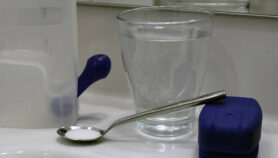By: Amantha Perera
Send to a friend
The details you provide on this page will not be used to send unsolicited email, and will not be sold to a 3rd party. See privacy policy.
[COLOMBO] Lack of a scientifically established cause, several risk factors and poor medical care are hampering efforts to thwart the spread of chronic kidney disease (CKD) in Sri Lanka, experts say.
Kamal Gammampila, a biomedical scientist affiliated to the Imperial College, London, says some 35,000 people are known to have died of CDK. “Presently there are 20,000 in end-stage kidney failure needing dialysis or a transplant, and 400,000 in various early stages of the disease.” According to data available at the presidential secretariat, over 1,000 fatalities are being reported annually.
The majority of the victims are male farmers in the northern and eastern agriculture belt of the island. Gammampila’s research suggests that the primary reason for the failure is high levels of cadmium absorbed through crops grown on contaminated plots. He says that by identifying such plots and making sure that crops such as rice are not grown on them the disease can be stemmed.

“Following birth, exposure to cadmium begins the very day a child is given solid food, hence their future kidney failure starts then. By maintaining a diet within safe limits we can prevent and eradicate kidney failure in 15—20 years,” he says.
Gammampila says the diets of those in possible risk areas should be carefully monitored. “Identify fields (paddy and vegetable) that produce highly toxic food. If the level is above 0.03 microgram per gram do not consume or blend with low- toxic food to keep level within above. That way, we will keep the cadmium exposure within safe dietary levels.”
Other researchers say that since the disease is usually detected once it has entered its final phase, many victims would continue with risky life styles, ignorant of the risk.
“Lack of the infrastructure, poor attitudes, low incomes, lack of awareness of CKD, long-term dehydration in warmer months of the year and inability to change lifestyles are the main barriers to control within a short period,” says Sunenthra Gunatilake, senior lecturer at the Sabaragamuwa University, Sri Lanka.
Gunatilake was part of a study published by her university in December 2004 that attributed CKD to ‘chronic exposure and cumulative effects of elevated levels of heavy metals associated with agricultural activities.’
The Sri Lankan government currently spends around US$ 2.8 million annually on tackling the disease with most of it going towards medical treatment. There are also plans to set up a US$100 million specialised facility for treatment.
Sri Lankan President Maithripala Sirisena has vowed to take assertive action to stop the spread of CKD and has suspended the import of fertiliser that is suspected to be a cause for high cadmium levels.
In May, Sirisena reinstituted a ban on the import of glyphosate, a weedicide suspected to be responsible for CKD. Sri Lanka first banned the sale of glyphosate in March 2014 but overturned the decision two months later, following a review.














